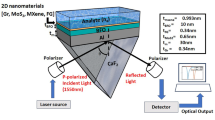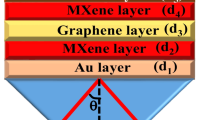Abstract
This work utilizes the modified Attenuated Total Reflection (ATR) configuration, to detect minute refractive index changes near the sensing surface. In the proposed ATR configuration, the presence of the graphene layer increases the interaction with bio-analyte by adsorbing the biomolecules and the presence of a thin silicon layer helps to enhance the sensitivity of the proposed device. The use of aluminum as the plasmonic metal serves an economical value as well as compatibility with the optoelectronic devices. All the geometrical parameters of the layers over the base index prism are engineered for maximum sensitivity and narrow linewidth in the optical communication band using the transfer matrix method. The stacking of silicon-graphene layers over the thin metal-coated glass prism leads to the maximum sensitivity of 200°/RIU and figure of merit of 95.23 RIU−1 at the wavelength of 1550 nm. To demonstrate the proposed device as a bio-sensor, rodent urine is considered as the analyte under test to detect the changes in the varying concentration of Leptospira bacterium. The proposed plasmonic device opens a new window for the detection of biomolecular interactions in the optical communication band.
Similar content being viewed by others
Data Availability
The dataset generated or analyzed during the current study are available from the corresponding author on reasonable request.
References
Khansili N, Rattu G, Krishna PM (2018) Label-free optical biosensors for food and biological sensor applications. Sensors Actuators: B Chem 265:35–49
Arora P, Krishnan A (2015) Fourier plane colorimetric sensing using broadband imaging of surface plasmons and application to biosensing. J Appl Phys 118(23):233105
Homola J (2008) Surface plasmon resonance sensors for detection of chemical and biological species. Chem Rev 108(2):462–493
Chen J, Fan W, Zhang T, Chaojun T, Xingyu C, JingJing W, Danyang L, Ying Y (2017) Engineering the magnetic plasmon resonances of metamaterials for high-quality sensing. Opt Express 25(4):3675–3681
Ahmadivand A, Gerislioglu B, Ahuja R, Mishra YK (2020) Terahertz plasmonics: the rise of toroidal metadevices towards immunobiosensings. Mater Today 32:108–130
Saber MG, Xu L, Sagor RH, Wang Y, Kumar A, Mao D, El-Fiky E, Patel D, Samani A, Xing Z, Jacques M, Mello YD, Plant DV (2020) Integrated polarisation handling devices. IET Optoelectron 14(3):109–119
Saber MG, Abadia N, Plant DV (2018) CMOS compatible all-silicon TM pass polarizer based on highly doped silicon waveguide. Opt Express 26(16):20878–20887
Arora P, Talker E, Mazurski N, Levy U (2018) Dispersion engineering with plasmonic nano structures for enhanced surface plasmon resonance sensing. Sci Rep 8(1):1–9
Con K, Lambert AS, Valiulis SN, Malinick AS, Tanabe I, Cheng Q (2020) Plasmonic biosensing with aluminum thin films under the Kretschmann configuration. Anal Chem 92:8654–8659
Arora P, Awasthi HV (2019) Aluminum-based engineered plasmonic nanostructures for the enhanced refractive index and thickness sensing in ultraviolet-visible-near infrared spectral range. Progress Electromagn Res M 79:167–174
Knight MW, King NS, Liu L, Everitt HO, Nordlander P, Halas NJ (2014) Aluminum for plasmonics. ACS Nano 8(1):834–840
Renard D, Tian S, Ahmadivand A, DeSantis CJ, Clark BD, Nordlander P, Halas NJ (2019) Polydopamine-stabilized aluminum nanocrystals: aqueous stability and Benzo[a]pyrene detection. ACS Nano 13:3117–3124
King NS, Liu L, Yang X, Cerjan B, Everitt HO, Nordlander P, Halas NJ (2015) Fano resonant aluminum nanoclusters for plasmonic colorimetric sensing. ACS Nano 9(11):10628–10636
Saber G, Sagor RH (2015) Design and study of nano-plasmonic couplers using aluminium arsenide and alumina. IET Optoelectron 9(3):125–130
Shalabney A, Abdulhalim I (2010) Electromagnetic fields distribution in multilayer thin film structures and the origin of sensitivity enhancement in surface plasmon resonance sensors. Sensors Actuators: A Phys 159(1):24–32
Homola J, Yee SS, Gauglitz G (1999) Surface plasmon resonance sensors: review. Sensors Actuators B Chem 54:3–15
Fu H, Zhang S, Chen H, Weng J (2015) Graphene enhances the sensitivity of fiber-optic surface plasmon resonance biosensor. IEEE Sensors J 15(10):5478–5482
Wu L, Chu HS, Koh WS, Li EP (2010) Highly sensitive graphene biosensors based on surface plasmon resonance. Opt Express 18(14):14395–14400
Verma R, Gupta BD, Jha R (2011) Sensitivity enhancement of a surface plasmon resonance based biomolecules sensor using graphene and silicon layers. Sensors Actuators: B Chem 160(1):623–631
Lahav A, Shalabaney A, Abdulhalim I (2009) Surface plasmon sensor with enhanced sensitivity using top nano dielectric layer. J Nanophotonics 3(031501):1–14
Zhan T, Shi X, Dai Y, Liu X, Zi J (2013) Transfer matrix method for optics in graphene layers. J Phys Condens Matter 25(21):1–8
S. Raikwar, Y. K. Prajapati, D. K. Srivastava, J. B. Maurya, and J. P. Saini (2020) Detection of leptospirosis bacteria in rodent urine by surface plasmon resonance sensor using graphene. Photonics Sensors. https://doi.org/10.1007/s13320-020-0587-2
Kumar A, Sharma AK (2018) Simulation and analysis of plasmonic sensor in NIR with fluoride glass and graphene layer. Photonics Nanostruct Fundam Appl 28:94–99
Shukla S, Venkatesh V, Arora P (2020) Highly sensitive self-referenced plasmonic devices based on engineered periodic nanostructures for sensing in the communication band. J Opt Eng 59(6):65101–65108
Maharana PK, Jha R (2012) Chalcogenide prism and graphene multilayer based surface plasmon resonance affinity biosensor for high performance. Sensors Actuators: B Chem 169:161–166
Malitson IH (1963) A redetermination of some optical properties of calcium fluoride. Appl Opt 2(11):1103–1107
Homola J (2003) Present and future of surface plasmon resonance biosensors. Anal Bioanal Chem 377(3):528–539
Rahman MS, Anower S, Hasan R, Hossain B, Haque I (2017) Design and numerical analysis of highly sensitive au-MoS2 -graphene based hybrid surface plasmon resonance biosensor. Opt Commun 396:36–43
Jha R, Sharma AK (2009) High-performance sensor based on surface plasmon resonance with chalcogenide prism and aluminum for detection in infrared. Opt Lett 34(6):749–751
Kim Y, Kwon M (2017) Electroabsorption modulator based on inverted-rib-type silicon waveguide including double graphene layers. J Opt 19(045804):1–9
Zhang L, Tang L, Wei W, Cheng X, Wang W, Zhang H (2016) Enhanced near-infrared absorption in graphene with multilayer metal-dielectric -metal nanostructure. Opt Express 24(18):1–8
Mohsin M, Neumaier D, Schall D, Otto M, Matheisen C, Giesecke AL, Sagade AA, Kurz H (2015) Experimental verification of electro-refractive phase modulation in graphene. Sci Rep 5(10967):1–7
Shu H, Su Z, Huang L, Wu Z, Wang X, Zhang Z, Zhiping Z (2018) Significantly high modulation efficiency of compact graphene modulator based on silicon waveguide. Sci Rep 8(991):1–8
Bhatia P, Gupta BD (2011) Surface plasmon resonance based fiber optic refractive index sensor: sensitivity enhancement. Appl Opt 50(14):2032–2036
Frisbie SP, Krishnan A, Xu X, de Peralta LG, Nikishin SA, Holtz MW, Bernussi AA (2009) Optical reflectivity of asymmetric dielectric-metal-dielectric planar structures. J Lightwave Technol 27(15):2964–2969
Panda A, Pukhrambam PD, Keiser G (2020) Performance analysis of graphene – based surface plasmon resonance biosensor for blood glucose and gas detection. Appl Phys A 126(3):1–12
Chen S, Lin C (2019) Sensitivity comparison of graphene based surface plasmon resonance biosensor with Au, Ag, and Cu in the visible region. Mater Res Express 6(056503):1–8
Maharana PK, Jha R, Palei S (2014) Sensitivity enhancement by air mediated graphene multilayer based surface plasmon resonance biosensor for near infrared. Sensors Actuators: B Chem 190:494–501
Prakash G, Srivastava RK, Gupta SN, Sood AK (2019) Plasmon-induced efficient hot carrier generation in graphene on gold ultrathin film with periodic array of holes: ultrafast pump-probe spectroscopy. J Chem Phys 151(234712):1–9
Koppens FHL, Chang DE, De Abajo FJG (2011) Graphene plasmonics: a platform for strong light-matter interactions. Nano Lett 11:3370–3377
Novko D (2017) Dopant-induced plasmon decay in graphene. Nano Lett 17:6991–6996
Rahman MS, Hasan R, Akter K, Anower MS (2018) A novel graphene coated surface plasmon resonance biosensor with tungsten disulfide (WS2) for sensing DNA hybridization. Opt Mater 75:567–573
Gan CH, Gan CH (2012) Analysis of surface plasmon excitation at terahertz frequencies with highly doped graphene sheets via attenuated total reflection. Appl Phys Lett 101(111609):1–4
Bezares FJ, De Sanctis A, Saavedra JRM, Woessner A, Alonso-gonza P, Amenabar I, Chen J, Bointon TH, Dai S, Fogler MM, Basov DN, Hillenbrand R, Craciun MF, Garcia de Abajo FJ, Russo S, Koppens FHL (2017) Intrinsic plasmon − phonon interactions in highly doped Graphene: a near-field imaging study. Nano Lett 17:5908–5913
Hoggard A, Wang L, Ma L, Fang Y, You G, Olson J, Liu Z, Chang W-S, Ajayan PM, Link S (2013) Using the plasmon linewidth to calculate the time and efficiency of electron transfer between gold nanorods and graphene. ACS Nano 7(12):11209–11217
Wijesinghe TM, Permarante M, Agarwal GP (2015) Low-loss dielectric-loaded graphene surface plasmon polariton waveguide based biochemical sensor. J Appl Phys 117(213105):1–10
Kitagawa YF, Takahashi T, Hayashi H (1981) Relationship between the refractive index and specific gravity of the rat urine. Exp Anim 30(3):307–311
Abbas A, Linman MJ, Cheng Q (2011) Sensitivity comparison of surface plasmon resonance and plasmon waveguide resonance biosensors. Sensors Actuators: B Chem 156(1):169–175
Li J, Ye J, Chen C, Li Y, Verellen N, Moshchalkov VV, Lagae L, Van Dorpe P (2015) Revisiting the surface sensitivity of nanoplasmonic biosensors. ACS Photonics 2(425–431):425–431
Verma A, Prakash A, Tripathi R (2015) Performance analysis of graphene based surface plasmon resonance biosensors for detection of pseudomonas-like bacteria. Opt Quant Electron 47:1197–1205
Verma A, Prakash A, Tripathi R (2015) Sensitivity enhancement of surface plasmon resonance biosensor using graphene and air gap. Opt Commun 357:106–112
Acknowledgements
The authors would like to thank the Birla Institute of Technology and Science, Pilani (Rajasthan), India for providing the Research Initiation Grant (RIG) and Additional Competitive Research Grant (ACRG). The authors would also like to thank Nihal Singh and Vishnu Venkatesh for the fruitful discussions.
Author information
Authors and Affiliations
Contributions
Both the authors contributed equally to the work.
Corresponding author
Ethics declarations
The authors declare no competing interests. This work does not contain any studies with human participants or animals performed by any of the authors.
Consent to Participate
Both the authors give their full consent.
Consent for Publication
Both the authors give their full consent for the publication.
Additional information
Publisher’s Note
Springer Nature remains neutral with regard to jurisdictional claims in published maps and institutional affiliations.
Rights and permissions
About this article
Cite this article
Shukla, S., Arora, P. Design and Analysis of Aluminum-Silicon-Graphene Based Plasmonic Device for Biosensing Applications in the Optical Communication Band. Silicon 13, 3703–3711 (2021). https://doi.org/10.1007/s12633-021-00953-4
Received:
Accepted:
Published:
Issue Date:
DOI: https://doi.org/10.1007/s12633-021-00953-4




